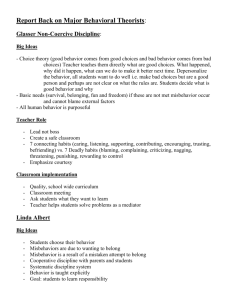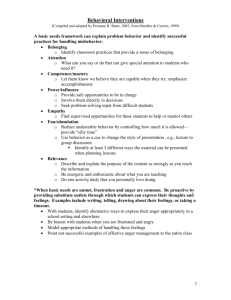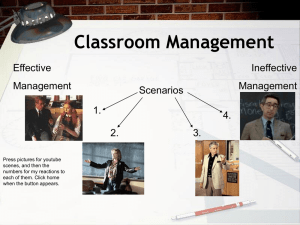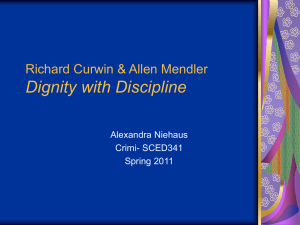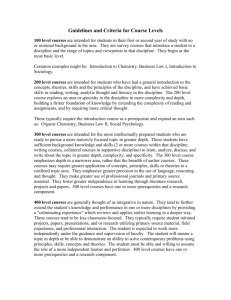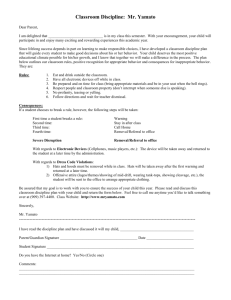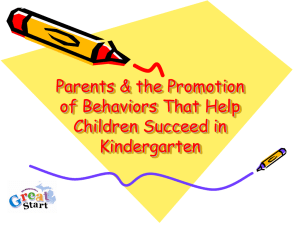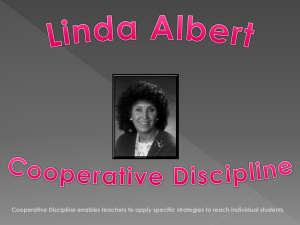Discipline With Dignity
advertisement
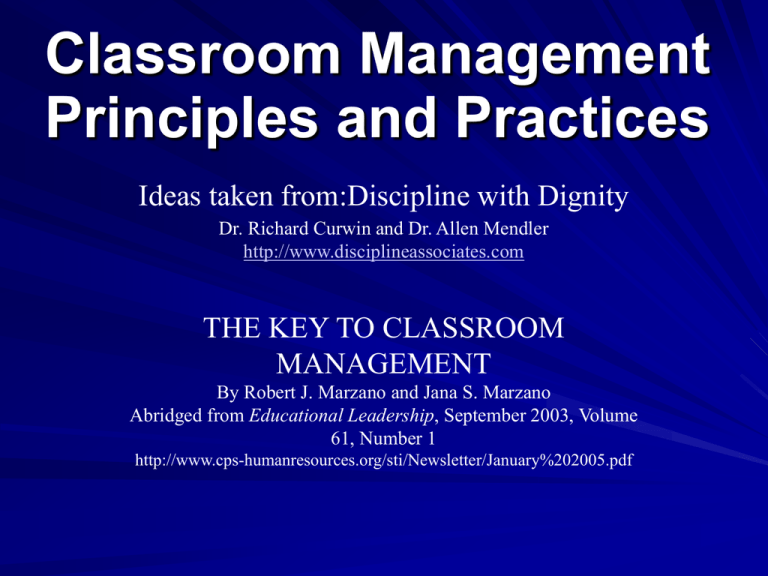
Classroom Management Principles and Practices Ideas taken from:Discipline with Dignity Dr. Richard Curwin and Dr. Allen Mendler http://www.disciplineassociates.com THE KEY TO CLASSROOM MANAGEMENT By Robert J. Marzano and Jana S. Marzano Abridged from Educational Leadership, September 2003, Volume 61, Number 1 http://www.cps-humanresources.org/sti/Newsletter/January%202005.pdf Self Check Strong-------------------------------------------Weak Where are you?? Sensitive---------------------------------Insensitive Relationships Don't Leave Relationships to Chance Teacher-student relationships provide an essential foundation for effective classroom management— and classroom management is a key to high student achievement. Think About This “The brain learns when connections are made between what is experienced and what that experience means to the child.” Copied from ISBE Welcome Letter - Christopher A. Koch, Ed.D Welcome Letter to Parents from Superintendent http://www.isbe.state.il.us/htmls/welcome_ltr_parents.htm THE KEY TO CLASSROOM MANAGEMENT Effective teacher-student relationships have nothing to do with the teacher's personality or even with whether the students view the teacher as a friend. Rather, the most effective teacher-student relationships are characterized by specific teacher behaviors: Behaviors Include Appropriate Levels of Dominance Establish Clear Expectations and Consequences Establish Clear Learning Goals Exhibit Assertive Behavior Appropriate Levels of Cooperation Provide Flexible Learning Goals Discipline with Dignity Philosophy Effective Communication – Take a Personal Interest in Students – Don't Leave Relationships to Chance Awareness of High-Needs Students I believe you can manage yourself You need to get a handle on your behavior because if you don’t I have a plan Philosophy (cont) Defusing potentially explosive situations To prepare children for their future To value and protect opportunities for learning Reducing violence Practical Discipline Guidelines The most practical discipline technique is to welcome every student. It takes less time at the end when you spend more time in the beginning. When students withdraw, make an even bigger invitation. Discipline responses require a twostage approach: stabilize and teach. Practical Discipline Guidelines Model effective expressions of anger with your students. When you take something away, give something back. Never use something you want a child to love as a consequence. Practical Discipline Guidelines Eventually you must face a student who misbehaves; no one can do it for you. When disciplining students, always provide choices and limits. No one can change his or her behavior without a commitment. Key to success of the program Treat students with dignity and respect Avoid power struggles Offer essential skills and strategies (you are a teacher not a policeman) Avoid reward / punishment based models Responsibility based discipline model Obedience o Based on rewards and punishments o Focuses on deterrents o Works best with students who don't need it o Appropriate for safety o Works fast, doesn't last Responsibility o Based on values; learning right from wrong o Focuses on instruction o Helps all students o Appropriate for all situations o Takes longer, lasts longer 4 factors that encourage self esteem in students Caring –Clearly defined limits Democratic atmosphere –Decision making and problem solving skills Other Important Points Establish clear and specific guidelines Listen to what students are thinking and feeling Use humor –Vary style of presentation –Offer choices Refuse to accept excuses Continued…… Be responsible (Yes it’s a big part of the job) Realize and accept you will not reach every child Start fresh every day


